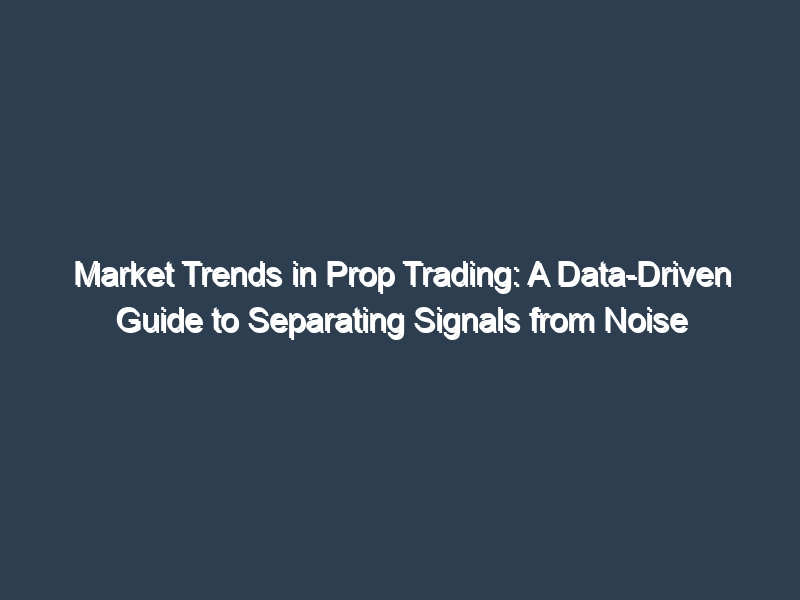
8 Feb
Market Trends in Prop Trading: A Data-Driven Guide to Separating Signals from Noise
Prop trading, or proprietary trading, has emerged as a dynamic force in the financial markets, undergoing significant evolution over the years.
As you navigate through the ever-changing market conditions and technological advancements, it is essential to understand the latest trends and strategies to achieve success.
This article will provide you with a clear definition and overview of the evolution of prop trading, highlight recent industry developments, and examine the crucial role that data plays in decision-making.
Additionally, it will discuss common pitfalls to avoid and share best practices to help you maximize profitability in this competitive landscape.
Understanding Prop Trading
Understanding prop trading is essential for anyone aiming to thrive in the dynamic landscape of financial markets. Prop trading, or proprietary trading, involves trading financial instruments using a firm’s own capital rather than clients’ funds.
This model enables firms to capitalize on market inefficiencies and volatility while employing various trading strategies to maximize returns. Over the years, prop trading has evolved significantly, integrating advanced technologies and data analytics to enhance trading performance and decision-making.
By looking into prop trading, you can gain insights into its unique advantages, strategies, and the skills necessary to succeed in this competitive environment.
Definition and Evolution of Prop Trading
Prop trading, or proprietary trading, refers to the practice where trading firms utilize their own capital to trade financial instruments rather than trading on behalf of clients. This allows firms to directly benefit from market trades.
This distinctive approach has its roots in traditional banking and investment sectors, where firms aimed to maximize profits beyond merely managing client assets. As technology has advanced, the trading landscape has transformed dramatically.
The emergence of algorithmic trading has introduced sophisticated systems that employ mathematical models to assess risks and opportunities at remarkable speed.
As a result, market participants now leverage quantitative analysis, enabling them to analyze vast amounts of data and execute trades based on precise calculations. This evolution has fostered a dynamic environment in which prop trading continues to thrive, offering unique strategies that capitalize on market inefficiencies.
Market Trends in Prop Trading
Staying informed about market trends in proprietary trading is essential for optimizing your trading strategies and achieving risk-adjusted returns. The financial markets are continually evolving, influenced by a variety of factors such as economic indicators, market sentiment, and macroeconomic conditions.
By understanding these trends, you can better anticipate potential market movements and make well-informed trading decisions. As a proprietary trader, it is imperative to analyze market data and trading signals to identify opportunities and effectively manage risks while navigating the complexities of market volatility.
Recent Developments and Shifts in the Industry
Recent developments in the prop trading industry have been significantly influenced by advancements in technology and changing market dynamics, particularly with the emergence of trading bots and high-frequency trading strategies.
These innovations have fundamentally transformed how you interact with financial markets, enabling faster execution of trades with enhanced precision and minimized human error. Algorithms designed for rapid decision-making allow you to capitalize on fleeting market opportunities while also increasing competition among market participants.
As these technologies become more integrated into trading practices, the implications for liquidity, market volatility, and overall trading strategies are substantial. You must now navigate a landscape where data analysis and machine learning are becoming critical tools, reshaping your approach to risk management and investment decisions.
The Role of Data in Prop Trading
Data plays a crucial role in prop trading, serving as the foundation for making informed decisions and optimizing trading performance.
As financial markets become increasingly complex, you will need to rely on quantitative analysis and predictive analytics to interpret market data effectively.
This data-driven approach not only enhances your understanding of market trends but also supports the development of robust trading strategies that can adapt to market fluctuations.
By leveraging real-time data and statistical models, you can improve your decision-making processes and achieve better risk-adjusted returns.
Types of Data Used in Prop Trading
In prop trading, you will utilize various types of data to guide your trading decisions, including market data, economic indicators, and trading signals. Each of these elements provides valuable insights into market behavior and trends.
Market data, such as price action and trading volume, plays a critical role in shaping your trading strategies. Price action offers a real-time view of how an asset is moving, allowing you to identify support and resistance levels. Meanwhile, trading volume indicates the strength of these movements, providing you with signals about potential reversals or continuations.
Economic indicators, such as employment figures and inflation rates, are essential for evaluating the overall economic environment and informing broader market perspectives.
By integrating this diverse data into robust trading systems, you can create strategies that are not only reactive but also proactive, aligning with market patterns and optimizing your performance.
How Data is Analyzed and Used for Decision Making
Data analysis in proprietary trading encompasses sophisticated techniques and methodologies that give the power to traders to make informed decisions based on quantitative insights derived from market conditions and historical performance.
These methodologies range from traditional statistical models to advanced machine learning algorithms, each offering unique advantages in comprehending market dynamics.
By utilizing backtesting, you can simulate your strategies against historical data, allowing you to refine your approaches before executing them in real-time.
This analytical rigor not only helps you identify potential trading opportunities but also aids in minimizing trading costs by optimizing execution strategies.
Ultimately, these data-driven techniques enhance your decision-making processes, ensuring that you remain competitive in an ever-evolving marketplace.
Separating Signals from Noise
Separating signals from noise is a fundamental aspect of successful proprietary trading. You must be able to discern actionable insights from the vast amount of data and market noise present in financial markets.
This skill is essential for making informed trading decisions and maximizing your effectiveness in a competitive environment.
Common Pitfalls and How to Avoid Them
In prop trading, it is essential for you to be aware of common pitfalls, such as cognitive biases and emotional decision-making, to maintain effective trading discipline and adhere to established trading rules.
Understanding these psychological factors can significantly enhance your ability to implement robust risk management strategies. By recognizing how market structure influences your judgment, you can develop more effective trading systems that minimize exposure to potential losses.
Employing techniques such as maintaining a trading journal or practicing mindfulness can assist you in fostering better emotional regulation. This awareness not only helps curb impulsive actions but also encourages you to adhere to your strategic plans, ultimately leading to more consistent performance in your trading activities.
Best Practices for Successful Prop Trading
Implementing best practices in proprietary trading is essential for achieving sustainable success and maximizing profitability in your trading activities.
Successful prop traders utilize well-defined trading strategies that incorporate risk management techniques and capital allocation principles, allowing them to navigate the complexities of financial markets effectively.
By adopting data-driven approaches and maintaining a disciplined trading mindset, you can significantly enhance your trading performance and adapt to market changes while managing your investment strategies effectively.
Strategies and Techniques for Maximizing Profitability
Maximizing profitability in prop trading requires the implementation of effective trading strategies that are tailored to current market conditions and your individual trading goals.
To achieve this, you can utilize several techniques, such as conducting thorough trend analysis to identify potential market movements and correlations.
Understanding how different assets move in relation to one another provides valuable insights that can enhance your decision-making. Employing algorithm optimization strategies allows you to fine-tune your trading algorithms, leading to more efficient execution and improved trading performance metrics.
By continuously assessing these metrics alongside market data, you can adjust your approaches, ultimately enhancing your profitability and strengthening your trading portfolio.
Frequently Asked Questions
What is prop trading and why is it important to stay updated on market trends?
Prop trading, or proprietary trading, is a form of trading where a firm uses its own capital to make trades and generate profits. It is important to stay updated on market trends in prop trading because it allows traders to make informed decisions and identify profitable opportunities.
How can data help in separating signals from noise in prop trading?
Data plays a crucial role in prop trading as it provides valuable insights and helps identify patterns and trends in the market. By analyzing data, traders can filter out unreliable information and make decisions based on solid evidence, thus separating signals from noise.
What are some common market trends that impact prop trading?
Some common market trends that impact prop trading include interest rates, geopolitical events, economic indicators, and stock market fluctuations. Keeping track of these trends can help traders anticipate market movements and make better trading decisions.
How do market trends affect prop traders’ strategies?
Market trends can greatly influence prop traders’ strategies, as they can indicate potential shifts in the market and impact the performance of different asset classes. Traders may need to adapt their strategies to align with the current market trends in order to stay profitable.
Why is having a data-driven approach important in prop trading?
A data-driven approach is crucial in prop trading as it allows traders to make decisions based on objective data rather than emotions or biases. This can help minimize risk and improve the overall success rate of trades.
What are some reliable sources for staying updated on market trends in prop trading?
Some reliable sources for staying updated on market trends in prop trading include financial news websites, market research reports, and data analysis tools. It is important to regularly check multiple sources to get a well-rounded understanding of the current market trends.
As you embark on your journey of identifying market trends in prop trading, remember that success comes from combining technical analysis with market psychology. Focus on developing a systematic approach to trend identification, and always validate your findings across multiple timeframes and indicators before making trading decisions.
Proudly powered byWordPress. Theme byInfigo Software.








